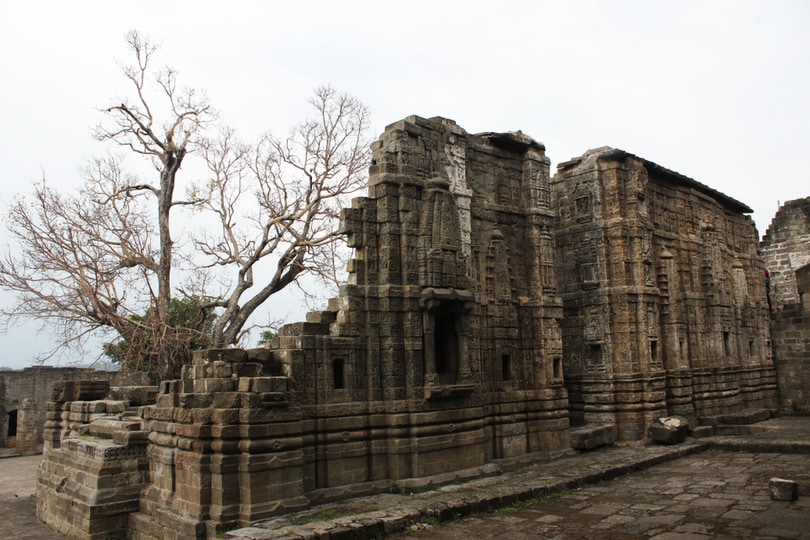The picturesque Kangra Fort is located at a distance of 20km from the town of Dharamsala on the outskirts of Kangra, Himachal Pradesh, India. It’s the largest fort in the Himalayas, and according to the Archaeological Survey of India, it is the 8th largest in the country – covering an area of 463 acres. It is also India’s oldest dated fort and is believed to have been built around 3500 years ago by Maharaja Susharma Chandra, a descendant of the Katoch family, according to the Archaeological Survey of India.
This royal Rajput family is said to have been founded by Rajanaka Bhumi Chand in 4300 B.C. Legend has it that there was a time when Goddess Ambika (a form of Goddess Parvati) was fighting a ferocious demon. In the long and hard battle, a drop of the goddess’s sweat fell on Earth. From this emerged Bhumi Chand of the Chandravanshi (the moon clan), who helped the goddess fight the demon. As a blessing, Ambika granted him the kingdom of Trigarta, located between the three rivers – Sutlej, Beas, and Ravi. Kangra is a part of this region.
It is believed that Maharaja Susharma Chandra of the Katoch dynasty had built Kangra Fort. He fought for Kauravas in the battle of the Mahabharata. After the defeat of Kauravas, Susharma Chandra didn’t return to his capital in Multan but came to Kangra along with his soldiers. He took Trigarta under his control and built a fort to protect his kingdom.
The kings of Hind, the chief of Kangra and all the rich devotees of the Brijeshwari Temple sent their treasures and precious jewels time after time to be presented to the large idol within the temple, so that they may receive a reward for their good deeds. Over the years, they had accumulated such an amount that the backs of camels could not carry it, vessels could not contain it, nor could writers record it, and neither could mathematicians calculate it. It is said that the fort is supposed to have had a greater quantity of gold, silver, precious stones and pearls than was ever collected in a Royal treasury.
Quite predictably, this fort has been subjected to countless attacks and almost all rulers who ever walked the land of India have tried to bring the Kangra Fort under their control as it was said: ‘He who holds the Kangra fort, holds the hills.’

The first attack on this fort was by the Raja of Kashmir, Shreshta in 470 A.D.
The earliest records of foreign invasions on Kangra fort refer to attacks by Mahmud of Ghazni back in AD 1009. The Persian ruler was said to be captivated by the immense treasures of the Kangra fort.
Muhammad Bin Tughlaq, the Turkic Sultan of Delhi, was the next ruler to capture the fort later in 1337. And after his death in 1351, his successor Feroze Shah Tughlaq conquered Nagarkot in the same year.
It is interesting to note that Mahmud was the first enemy to ever step foot in the fort. His attack was so swift that the garrison commanding the fort and the town could not even close the gates of the city wall (the Katoch armies had been greatly reduced in number because the Raja of Kangra Jagdish Chandra was out on campaign against the Raja of Kaluta – present-day Kullu).
After gaining access to the town, the sultan blackmailed the garrison commander within the fort by threatening the lives of the town citizens. Under these circumstances, the fort was handed over to the sultan who, after taking control of the fort, killed all its occupants. Abu Nasir Ahmed bin Mohammad Farighuni the ruler of Juzjani, Altuntash, and Asightigin (Sultan’s chief chamberlains) – were appointed in-charge of the gold and silver. The sultan himself took charge of the jewels.
The Kangra fort is said to have 21 treasure wells – each well is 4 meters deep and about 2 and a half meters in circumference-the Sultan of Ghazni looted eight wells, the British in the 1890s found five more wells. Local belief is that the fort still hides eight more treasure wells within its walls.
In 1619, the Mughal army laid siege to the fort for nearly 14 months – 52 unsuccessful attempts had been made to lay siege since 1615 by Akbar. And finally, in 1620, Akbar’s son, Jahangir captured this fort.
In 1758, Sansar Chand’s grandfather, Ghamand Chand the predecessor of the Katochs, had been appointed the governor of Jalandhar by Ahmed Shah Abdali. Using his familial background, Sansar Chand rallied an army, ousted the then-ruler of Kangra, Saif Ali Khan, and succeeded in recovering the ancient fort of his ancestors in 1789.
Maharaja Sansar Chand had successfully established himself as a powerful ruler till that time and was able to make a deal with Jai Singh (King of Jaisinghpur in Kangra Valley). So, he gained control over the fort. He had to give some plain territories to Jai Singh in return.
This was when Sansar Chand emerged as a dominating ruler and conquered almost all neighboring regions, including Chamba, Kahloor, Mandi, and Sirmaur.
All the defeated hill kings then sought help from Amar Singh Thapa, the Gurkha commander, and came together against Sansar Chand. They invaded Kangra with Gurkha troops and won the fort.
Maharaja Sansar Chand fought multiple battles with the Gurkhas on one side and another king, the Sikh Maharaja Ranjit Singh, on the other.
During the battle, the gates of the fort had been kept open for supplies. The Gurkha army entered the open and scarcely armed gates in 1806. This forced an alliance between Sansar Chand and Ranjit Singh. Sansar Chand had to agree to hand over Sandhata district and the Kangra fort to the Lahore Darbar. A treaty was signed and the rulers of Kangra never gained control of the fort again, and the Gurkhas eventually left too. The fort was finally taken by the British after the Sikh war of 1846.
A British garrison occupied the fort until it was heavily damaged in an earthquake on April 4, 1905.
The magnitude-7.8 earthquake killed more than 20,000 people. Apart from this, most buildings in the towns of Kangra, Mcleodganj, and Dharamsala were destroyed. What no army could do in hundreds of years, nature did – it shook the very foundations of the Kangra fort.
The fort is spread over a large area via a 4-km-long outer circuit. The entire fort is guarded by high ramparts and massive walls of black stones. The highest point is occupied by the palace courtyard, below which there is a large courtyard containing the stone-carved temples of Laxmi Narayan, Ambika Devi and the Jain Temple (a point of pilgrimage for the Jains as it holds the original idol of Mahavir). The fort has a total of 11 gates and 23 bastions.
The temple courtyard is closed by the Darshani Darwaza (the gate of worship), the next gate leading up from here is called the Mahlon ka Darwaza (palace gate).
This gate is a passage 7 m in length and is wide enough only for two men (shoulder to shoulder) or one horse to pass through. Its walls are almost 15 feet high. This was built to stop/slow down the charge of an enemy army – above the side walls are flat grounds that accommodated the Katoch army, which defended these gates from the vantage point.
After independence, the Archaeological Survey of India returned the fort to Maharaja Jai Chandra under a management agreement of national importance. The only portions of the fort still under the control of the present family are the temples and parts of the palace courtyards. The Katochs still come to offer their prayers to their deity, Goddess Ambika Devi, whose temple remains intact inside the fort.

The Kangra Fort is situated at a distance of 20 km from Dharamsala. Dharamsala is easily accessible from cities like Delhi, Shimla, and Chandigarh via road. After reaching the Kangra Town, the Fort can be reached via an auto-rickshaw or car or other means of road transport.

If you find yourself at the Kangra Fort, it is suggested that you should take the audio guide offered by the current head of the Katoch Dynasty, Tikaraj Aishwarya Katoch for a truly enriching and informative experience. Tikaraj Aishwarya Katoch is the present scion of the erstwhile Katoch dynasty. When he first entered the fort, the tip given to him by his grandfather was “You must pass through the gate leg first, never lead with your head because if there’s an enemy on the other side, you might lose your head”. He narrates many such anecdotes and speaks about a lot of tales associated with the fort in the audio tour guide provided by the Archeological Survey department of India when you visit the fort.
The fort lies in ruins. However, the vagaries of time have not been able to erase its glorious past. Visit this place to explore the glorious history of this region and immerse yourself in the beautiful surroundings. Kangra Fort is a history buff’s delight and a treat to sore eyes.

Please go back to portrait mode for the best experience